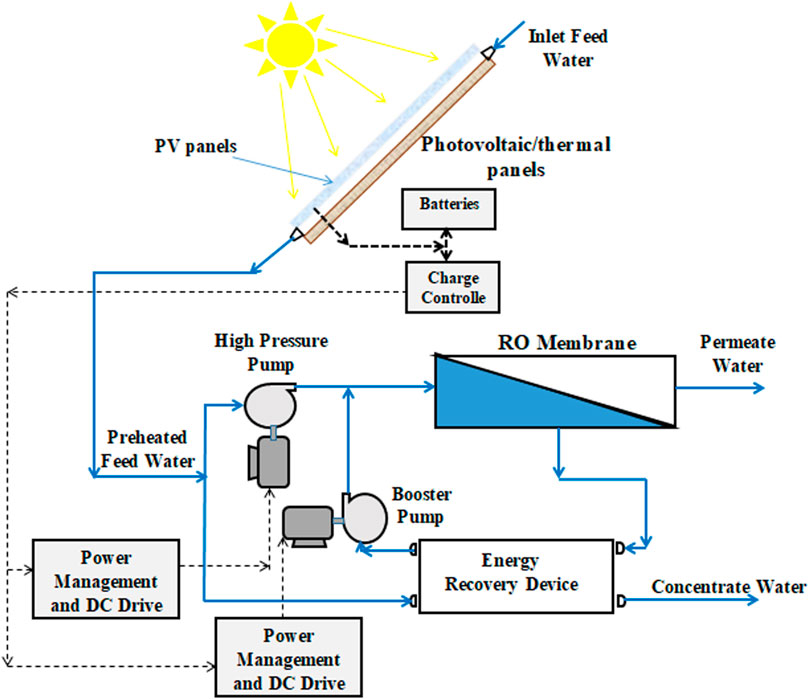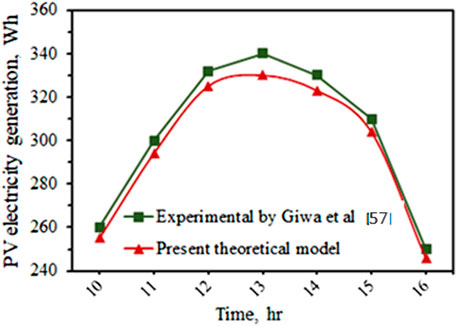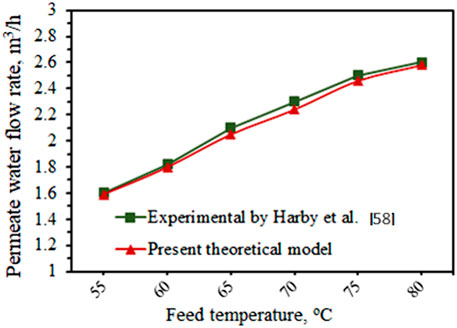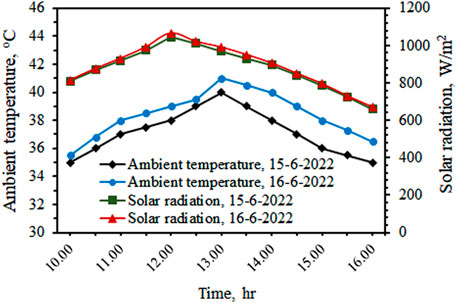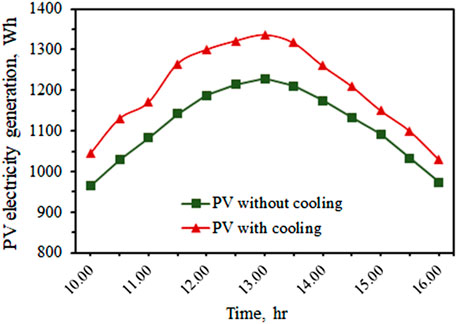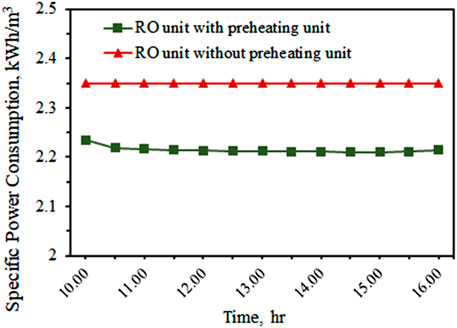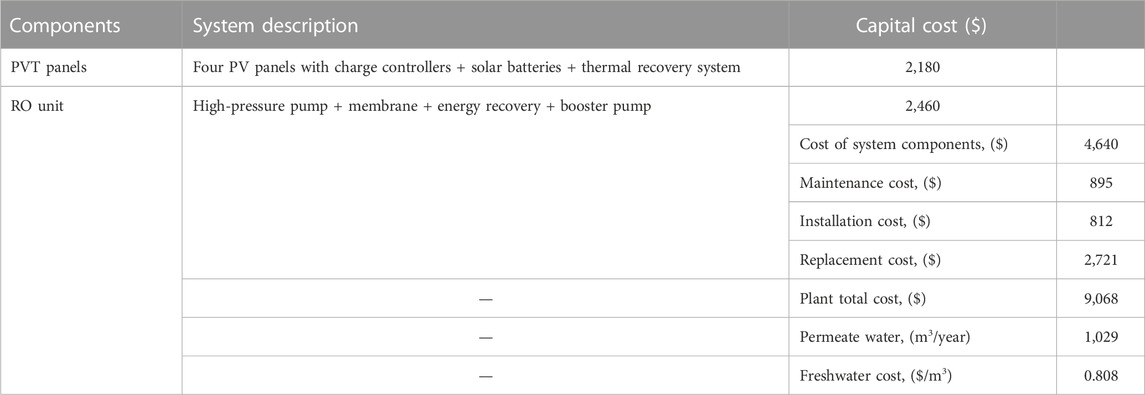- 1Department of Mechanical Engineering, College of Engineering in Al-Kharj, Prince Sattam Bin Abdulaziz University, Al-Kharj, Saudi Arabia
- 2Mechanical Power Engineering Department, Faculty of Engineering, Tanta University, Tanta, Egypt
- 3Basic Science Department, Faculty of Engineering, Delta University for Science and Technology, Gamasa, Egypt
- 4Faculty of Engineering, Delta University for Science and Technology, Gamasa, Egypt
- 5Department of Mechanical Engineering, Islamic University of Madinah, Medina, Saudi Arabia
Middle East and North Africa (MENA) countries are experiencing rapid population growth, so water and electricity consumption plays a crucial role in the sustainable development of these countries. To overcome the water scarcity and electricity problems facing the MENA region, the developed cooling/preheating small PVT-RO desalination plants have been proposed as a practical solution. To achieve sustainable water and energy development in the MENA region, this study presents a commendable and highly efficient renewable energy project for freshwater production and electricity generation to solve the energy crisis and water scarcity in the MENA countries. Therefore, this study aims to develop a cooling/preheating small PVT-RO desalination plant to facilitate freshwater supply to remote regions and produce electricity. This was done by connecting photovoltaic/thermal (PVT) collectors with reverse osmosis (RO) desalination systems, where seawater is used as a medium to cool photovoltaic cells to increase electric power generation and at the same time recover thermal energy and use it in the initial heating of feed seawater before it is fed into the RO plants, thus increasing its productivity. The results indicate that using the photovoltaic thermal panels as preheating units will lead to a 0.135 kWh/m3 reduction in the rate of specific electricity consumption for the RO desalination plant, as well as increase the electricity generation from PVT panels by a rate of 8%. The economic feasibility presented that the proposed developed cooling/preheating small PVT-RO desalination plant represents an effective technology that reduced the freshwater cost by a rate of 49.5%.
1 Introduction
About 6.3% of the world’s population lives in the Middle East and North Africa (MENA) region, where the proportion of freshwater is estimated at only 1.4% of the world’s renewable freshwater (Al-Rimmawi, 2012). Therefore, the MENA regions are one of the most water-scarce regions in the world. Food, energy, and water supplies are among the basic foundations of life for all societies, which depend mainly on electricity and water infrastructure (Bhaduri et al., 2015; Mabrey et al., 2018). Economic development in MENA countries entails increased demand for energy and water resources (Granit and Löfgren, 2010), notwithstanding climate changes facing the whole world (Al-Sumaiti et al., 2017; Saad Al-Sumaiti et al., 2019). The latest data from the past 10 years showed that the rate of progress in achieving sustainable development goals is slow due to inflation in the global economy (Barbier and Burgess, 2019). Despite slow progress in economic growth over the past 10 years, about a third of the world’s population still lacks access to clean cooking and electricity in 2020 as population growth has outpaced economic growth. It is projected that by 2030, 670 million people will still lack energy and about 2.1 billion people will lack access to clean cooking (van Meijl et al., 2020).
Africa’s freshwater and energy situation is unique compared to that of the rest of the world, which is due to the economic and social situation of the African continent, as it is the second most populous continent (Mandelli et al., 2014). MENA countries experienced a population growth of 2.5% in 2010, the rate of average growth for Africa was 2.1% based on the International Energy Agency, and Europe achieved a growth rate of about 0.3% (Chong and Poole, 2013). The growth rate of the African economy is fast compared to the growth rate of the economy in Asia (Chong and Poole, 2013). Despite the advantages of the African economy, there is a large gap and inequality between the urban and rural settlements of many African countries, which causes the emergence of poverty at high rates in large sectors of the population (Griffiths, 2017). Ten countries in Africa, namely, Egypt, Morocco, Algeria, Tunisia, Libya, South Africa, Angola, Nigeria, Ethiopia, and Sudan, contribute 75% of the GDP, while the remaining 25% is provided by the rest of the African countries (Leibfritz and Flaig, 2013). Concerning the aforementioned facts, we find that the MENA region deserves more focus in the discourse of the global water and energy crisis as the MENA region plays an active role in a system of global energy as a huge producer of fossil fuels. The region also has another natural resource, which is gas, with an estimated oil production capacity of about 860 billion barrels (Stambouli et al., 2012). Table 1 presents the reserves of fossil fuel in some North African countries.

TABLE 1. Fossil fuel reserves in some North African countries (Ghazi et al., 2021).
All countries of the MENA region suffer from water scarcity, where the per capita share of water is below 1,000 m3/year (Fitton et al., 2019). The relationship between water and energy in MENA was reviewed by Siddiqi and Anadon (2011), and it was found that production of freshwater is highly dependent on energy. Their study indicated that the total fuel consumption in wastewater treatment and groundwater pumping operations is estimated at approximately 14% of total fuel consumption in Egypt and Libya. This confirms that there is a close relationship between water and energy, which is a cause for concern in MENA. There is an urgent need for sustainable water management in the North African region, where water scarcity has been increasing. A significant decrease in the level of groundwater has been observed in places depending on groundwater, and consequently, they are more prone to drought (Oweis and Hachum, 2003). It was clarified based on reports that Egypt has reached the water poverty line, as the per capita share of water has decreased to 500 cubic meters per year, which is less than the average consumption of 1,000 cubic meters per person (Almaktar and Shaaban, 2021). Likewise, Libya is considered one of the most water-stressed countries in the world due to the excessive exploitation of groundwater, poor water management, and seawater intrusion (Brika, 2018).
Desalination systems are one of the most important ways to solve the global water crisis (Jones et al., 2019). The production capacity of drinking water produced from desalination plants is estimated at more than 100 million cubic meters per day worldwide through 16,000 plants spread over 175 countries around the world. It is estimated that the amount of water produced by desalination plants in MENA accounts for nearly half of the global capacity (Adun et al., 2022). The challenge facing desalination technologies is that they are energy-intensive. Nowadays, in the Middle East and North Africa, most desalination plants are operated using fossil fuels, and this has serious repercussions on the environment and contributes to global warming. Therefore, there is an increasing interest in the use of renewable energy in the desalination process in the MENA region in order to provide a safe climate environment and to reduce water poverty, due to the close relationship between water and energy (Aghahosseini et al., 2020).
An estimated 70% of the world’s freshwater resources are consumed in agriculture, according to a report by the Food and Agriculture Organization (2011), and about 30% of the energy used globally is consumed in food production and distribution (Woods et al., 2010). Recently, as a result of increased food demand due to population growth, for sustainable development, water conservation has been given high priority in relation to food security concerns in the MENA region (Murad et al., 2007) because economic and social development depends on a sustainable supply of water and electricity (Li et al., 2018), especially in arid countries (Al-Sumaiti et al., 2014). Despite the strong correlation between water and energy, management and assessment are not fully considered in operating wastewater and electricity systems (Farid et al., 2016). The global economic crisis is considered one of the most serious constraints facing all countries of the world in achieving sustainable development goals, as industrial competitiveness and high-income countries are considered more effective in achieving sustainable development goals than their low-income counterparts (Sovacool et al., 2021; Cheng et al., 2023). Kirby et al. (2021) evaluated community-level infections resulting from wastewater pathogens. Bose et al. (2018) studied the impacts of pH, temperature, concentration, the nature of electrodes, and operating period on the performance of microbial fuel-cells. Bose et al. (2020) used bioelectrochemical systems to bring down the level of contamination and recover energy from wastewater.
The scarcity of resources of fresh water is one of the most important issues facing the world in the twenty-first century (Bacha et al., 2023; Younes et al., 2023). It is expected that by 2030, the scarcity of freshwater resources will affect 40% of the world’s population (Mekonnen and Hoekstra, 2016). There is an unfortunate situation faced by most countries of the world, which is that most of the available water on Earth is saltwater found in seas and oceans, and freshwater accounts for less than 3% of water resources globally (Kalogirou, 2005). In addition, the amount of freshwater available for direct use is estimated to be less than 1% (Khan et al., 2018). Due to population growth, improved quality of life, urbanization, and industrialization in the MENA region, and due to low rainfall in the MENA region, historically, most MENA regions relied on groundwater as a major water resource (Gleick et al., 2013). Due to climatic changes and high evaporation rates, groundwater is not considered a sustainable water source (Gleick et al., 2013). Given the increasing demand for freshwater, this confirms greatly the urgent need to provide a sustainable source of freshwater. Desalination systems are considered energy-intensive, and water desalination systems in MENA depend mostly on fossil fuels as a primary source of energy (Eldean and Soliman, 2017). As a result of serious environmental pollution and fossil fuel emissions, it is not a sustainable option (Elsaid et al., 2020a; Elsaid et al., 2020b). Shahzad et al. (2014) numerically studied the effect of incorporating the adsorption desalination with the last effect of the multi-effect desalination plant. Ng et al. (2015) have undertaken future development of desalination plants for places suffering from water poverty by incorporating the adsorption desalination with the multi-effect desalination plant. Shahzad et al. (2015) experimentally studied the performance of a hybrid desalination system that incorporates the adsorption desalination with the last effect from the three stages of the multi-effect desalination plant. They found that the distillate productivity of this hybrid system was improved by 2.5–3 compared to classical multi-effect desalination plants.
Table 2 presents the energy rates required for the different desalination technologies and the emissions associated with them. Desalination systems consume 75 TWh energy annually, which is almost 0.4 % of the global electricity production, and produce about 76 million tons of carbon dioxide annually, and the annual percentage of carbon dioxide production is expected to reach 218 million tons by 2040 due to the expansion of the establishment of desalination plants (Shahzad et al., 2017). Therefore, the use of renewable energy for desalination is an effective and practical solution to reduce the burden on fossil fuel use for desalination and reduce the environmental impacts of the desalination process using fossil fuels. One of the negative effects of using new and renewable energy in water desalination is its low production compared to fossil energy (Olabi et al., 2020; Rabaia et al., 2021).

TABLE 2. Energy requirements for various desalination technologies (Elsaid et al., 2020a; Elsaid et al., 2020b).
The reverse osmosis desalination technologies have found widespread application in producing fresh drinking water. This was a recent development; therefore, the top priority now is to devise various optimization techniques to increase the productivity of this type of plant and reduce energy consumption rates through the sustainability criteria. The specific energy saving varies between 0.69 and 0.79 kWh/m3 due to the effect of incorporating an energy recovery device with an RO unit (Park et al., 2020) The temperature of feed seawater is one of the important variables that have a direct impact on the operation of reverse osmosis (RO) plants and their performance. Therefore, the performance of RO desalination units was evaluated throughout the four seasons of the year in order to show the general positive and negative effects of changing the feed seawater temperature. The evaluation process showed an improvement in membrane permeability and a decrease in the viscosity of the water with increase in feedwater temperature (Hills et al., 2021), where water permeability improved by 3% for every one degree Celsius temperature rise in the feed seawater, while the quality of the freshwater produced decreased with the increase in the feed seawater temperature (Atab et al., 2016). The efficiency of both the pumps and the energy recovery device results in a decrease in the viscosity of the feedwater with an increase in its temperature (Wu et al., 2017). Karellas et al. (2011) evaluated the performance of a reverse osmosis desalination system supported by hybrid photovoltaic panels—the organic solar Rankine cycle suitable in remote areas. The cost of producing potable water reached 6.52 €/m3 using this proposed desalination system. Caldera et al. (2016) evaluated the behavior of RO plants powered by photovoltaic wind turbines as renewable energy sources. They found that the cost of water varies between 0.59 €/m3 and 2.81 €/m3. Shahzad et al. (2017) projected that the energy consumed by desalination processes worldwide reached 75.2 TWh per year, and the expected increase in desalination CO2 emission is 218 Mt per year by 2040.
The current study aims to develop a stand-alone small RO desalination unit to facilitate freshwater supply to remote regions of the MENA region and to overcome the water scarcity and electricity problems facing the remote areas of the MENA region. This was done by connecting solar PVT panels with a small RO desalination plant, where seawater is used as a medium to cool photovoltaic panels to increase the electric power generation rates and, at the same time, recover thermal energy and use it in the initial heating of feed seawater before it is fed to the reverse osmosis desalination plants, thus increasing its production and reducing the rates of specific energy consumption. In addition, this paper presents an economic analysis to demonstrate the economic feasibility of utilizing the proposed developed cooling/preheating small PVT-RO desalination plant.
2 Proposed system configuration
The present study aims to develop a small desalination unit to facilitate freshwater supply to remote regions of the MENA region. This developed system aimed to produce freshwater at a higher rate and produced the required electricity to operate the suggested small desalination unit. This is because there are many remote areas in the MENA that suffer from scarcity of freshwater and electricity from the viewpoint of the close relationship between the supply of freshwater and electricity. Therefore, this study aimed to present a developed system for remote areas in the MENA that suffer from scarcity of freshwater and electricity that can produce freshwater at high rates and generate electricity. This was done by connecting solar photovoltaic/thermal (PVT) cells with RO plants with the energy recovery device (ERD), where seawater is used as a medium to cool the PV panels to increase the electricity generation, as well as to heat the seawater before it is fed into the RO desalination unit, thus increasing its productivity. The proposed system shown in Figure 1 consists of PVT panels, an RO unit, an energy recovery device (ERD), a boost pump, batteries, a high-pressure pump, charge controllers, and power management and DC drive.
3 Mathematical modeling
This section includes modeling PVT plates and RO units with ERD. Theoretical analysis is the most important tool for judging the contribution of PVT to improving the freshwater yield and specific energy consumption for RO units with ERD.
3.1 Modeling of PVT panels
This section deals with the equations that describe the performance of PVT panels (Abdelgaied et al., 2021; Abdelgaied et al., 2022a):
Thermal efficiency of the PVT panel’s ηth was calculated as follows:
Here,
Here,
The removal factor (FR) is calculated as follows:
Here,
The electrical efficiency of PVT ηelec is as follows:
Here,
3.2 Modeling of reverse osmosis
This section presents the equations that describe the performance of an RO unit with an ERD as follows (Abdelgaied et al., 2021; Abdelgaied et al., 2022a):
The permeate flow rate
Here,
The recovery ratio RR is calculated as follows:
Osmotic pressure (π) is calculated as follows:
Permeate salt concentration (Cp) is calculated as follows:
Here,
The power consumption (
Here, ηHPP is the efficiency of the pump = 75% and ηERD is recovery device efficiency = 80%.
4 Model validation
4.1 Model validation of PVT panels
The results of a present theoretical model of the PVT panel were compared with the results of a previous study published by Giwa et al. (2016) in order to confirm the validity of the PVT panel theoretical model, as shown in Figure 2. It is observed from the figure that the maximum deviation in the generated power rates is within 4.34%. Thus, the proposed theoretical model for evaluating the performance of PVT modules has a high accuracy for predicting the behavior of PVT panels.
4.2 Model validation of the RO unit
The results of a present theoretical model of an RO unit with ERD were compared with the results of a previous model published by Harby et al. (2021) in order to confirm the validity of the RO unit theoretical model, as shown in Figure 3. It is observed from the figure that the maximum deviation in the permeate water is within 3.73%. Thus, the proposed theoretical model for evaluating the behavior of RO units with ERD has a high accuracy for predicting their behavior.
5 Results and discussion
Weather and climate conditions (ambient temperature and solar radiation intensity) represent the main parameter that influences the behavior of the proposed RO unit with ERD that is driven by PVT panels in its evaluation. Figure 4 shows the weather and climate conditions of Tanta city under Egyptian meteorological conditions. Figure 4 shows the variations in ambient air temperatures and the intensity of solar rays from 10:00 am to 4:00 pm. As presented, the intensity of solar rays reached the maximum of 1,045 and 1,054 W/m2 at 12:00 am on 15 June and 16 June 2022, respectively. In addition, within this period, the temperature of ambient air varied between 35–40°C and 35.5.5–41°C for 15 July and 16 July, respectively.
The PVT panels represent the electricity source that generates the electric power required to drive the RO unit, as well as the preheating unit, to heat the feed seawater before it enters the RO units. As shown in Figure 5 the hourly variations of electric power generation from PV panels without thermal recovery varied between 895 and 1,335 Wh, but by using the thermal recovery, the electricity generation was improved, and it varied between 890 and 1,350 Wh, with an average improvement of 8%.
Figure 6 shows the impacts of the use of PVT panels as pre-heating units on the power consumption of RO-ERD units. As shown in Figure 6, the specific power consumption will decrease with an increase in the feed temperatures of seawater entering the RO unit. For the conventional RO-ERD unit without the preheating unit, the specific consumption reached 2.35 kWh/m3, but by utilizing the PVT panels as the preheating unit to heat the feed seawater before entering the RO unit, the specific energy consumption rates reduced and varied between 2.21 and 2.235 kWh/m3 from 10:00 am to 4:00 pm; this was a positive effect of the preheating unit. The results indicate that using the photovoltaic thermal panels as preheating units will lead to a 0.135 kWh/m3 reduction in specific electricity consumption on average.
6 Economic feasibility
To demonstrate the economic feasibility of the developed cooling/preheating small PVT-RO desalination plant, the cost of freshwater produced from the developed cooling/preheating small PVT-RO desalination plant was calculated based on the total capital cost, maintenance cost, installation cost, replacement cost, and freshwater that can be produced from the developed cooling/preheating small PVT-RO desalination plant using the procedure presented by Ammous et al. (2016) (Table 3). As shown, the cost of freshwater produced from the proposed system was 0.808 $/m3 compared to 1.07 $/m3 for the system proposed by Abdelgaied et al. (2021) and 1.6 $/m3 for the system proposed by Anand et al. (2021). The results showed that the developed cooling/preheating small PVT-RO desalination plant is a good choice because it reduced the cost of freshwater produced from the developed cooling/preheating small PVT-RO desalination plant by 49.5% compared with the results of Anand et al. (2021) and by 24.5% compared with the results of Abdelgaied et al.( 2022b).
7 Conclusion
To overcome the water scarcity problem facing MENA regions, seawater desalination systems have been proposed as a practical solution as most MENA regions have easy access to salt water. However, seawater desalination processes require vast amounts of energy. With the aim of achieving sustainable water and energy development in the MENA region, this study presents a commendable and highly efficient renewable energy project for freshwater production and electricity generation to solve the water scarcity and energy crisis. During the past decade, much attention has been given to improving the performance of desalination plants on an industrial scale. Hence, the current simulation model aims to develop small desalination units to facilitate freshwater supply to remote regions. This was done by connecting photovoltaic thermal (PVT) cells with RO water desalination systems, where seawater is used as a medium to cool the photovoltaic cells to increase the electric power generation rates and, at the same time, recover thermal energy and use it in the initial heating of the feed seawater before it is fed to reverse osmosis (RO) plants, thus increasing its productivity. The main results are as follows:
• The average improvement in output electricity generation for the use of cooling technology is 8%.
• The specific energy consumption of a conventional RO unit without a preheating unit is 2.35 kWh/m3, but by using PVT panels as the preheating unit to heat feed seawater before it is fed to the RO unit, the specific energy consumption rates decreased and ranged between 2.21 and 2.235 kWh/m3.
• The results indicate that using the photovoltaic thermal panels as preheating units will lead to a 0.135 kWh/m3 reduction in specific electricity consumption on average.
• The economic feasibility presented that the proposed developed cooling/preheating small PVT-RO desalination plant represents an effective technology that reduced the freshwater cost by a rate of 49.5%.
The results presented that the incorporation of PVT panels with the RO desalination unit represents a good choice for the remote areas in the MENA that suffer from scarcity of freshwater and electricity.
Data availability statement
The raw data supporting the conclusion of this article will be made available by the authors, without undue reservation.
Author contributions
HB: investigation, software, validation, and writing–original draft. AA: conceptualization, formal analysis, funding acquisition, methodology, supervision, and writing–original draft. UA: formal analysis, investigation, methodology, validation, writing–review and editing, resources, and writing–original draft. RS: investigation, methodology, visualization, and writing–review and editing. MA: conceptualization, data curation, formal analysis, investigation, resources, and writing–original draft. AK: conceptualization, investigation, methodology, project administration, supervision, and writing–original draft.
Funding
The author(s) declare no financial support was received for the research, authorship, and/or publication of this article.
Acknowledgments
The authors extend their appreciation to the Deputyship for Research and Innovation, Ministry of Education in Saudi Arabia, for funding this research work through the project number (IF2/PSAU/2022/01/21835).
Conflict of interest
The authors declare that the research was conducted in the absence of any commercial or financial relationships that could be construed as a potential conflict of interest.
The author(s) declared that they were an editorial board member of Frontiers at the time of submission. This had no impact on the peer review process and the final decision.
Publisher’s note
All claims expressed in this article are solely those of the authors and do not necessarily represent those of their affiliated organizations, or those of the publisher, the editors, and the reviewers. Any product that may be evaluated in this article, or claim that may be made by its manufacturer, is not guaranteed or endorsed by the publisher.
References
Abdelgaied, M., Abdullah, A. S., Kabeel, A. E., and Abosheiasha, H. F. (2022a). Assessment of an innovative hybrid system of PVT-driven RO desalination unit integrated with solar dish concentrator as preheating unit. Energy Convers. Manag. 258, 115558. doi:10.1016/j.enconman.2022.115558
Abdelgaied, M., Kabeel, A. E., and Abdullah, A. (2022b). Performance optimization of the hybrid HDH-RO desalination system powered by photovoltaic-thermal modules using solar dish concentrators. Int. J. Energy Res. 46 (11), 14946–14963. doi:10.1002/er.8196
Abdelgaied, M., Kabeel, A. E., Kandeal, A. W., Abosheiasha, H. F., Shalaby, S. M., Hamed, M. H., et al. (2021). Performance assessment of solar PV-driven hybrid HDH-RO desalination system integrated with energy recovery units and solar collectors: theoretical approach. Energy Convers. Manag. 239, 114215. doi:10.1016/j.enconman.2021.114215
Adun, H., Ishaku, H. P., and Ogungbemi, A. T. (2022). Towards renewable energy targets for the Middle East and North African region: a decarbonization assessment of energy-water nexus. J. Clean. Prod. 374, 133944. doi:10.1016/j.jclepro.2022.133944
Aghahosseini, A., Bogdanov, D., and Breyer, C. (2020). Towards sustainable development in the MENA region: analysing the feasibility of a 100% renewable electricity system in 2030. Energy Strateg. Rev. 28, 100466. doi:10.1016/j.esr.2020.100466
Almaktar, M., and Shaaban, M. (2021). Prospects of renewable energy as a non-rivalry energy alternative in Libya. Renew. Sustain. Energy Rev. 143, 110852. doi:10.1016/j.rser.2021.110852
Al-Sumaiti, A. S., Ahmed, M. H., and Salama, M. (2014). Residential load management under stochastic weather condition in developing countries. Electr. power components Syst. 42 (13), 1452–1473. doi:10.1080/15325008.2014.933375
Al-Sumaiti, A. S., Salama, M. M. A., and El-Moursi, M. (2017). Enabling electricity access in developing countries: a probabilistic weather driven house based approach. Appl. Energy 191, 531–548. doi:10.1016/j.apenergy.2017.01.075
Ammous, M., Charfi, S., Harb, A., and Chaabene, M. (2016). Improvement of PV/T based reverse osmosis desalination plant performances using fuzzy logic controller. Int. J. Mod. Nonlinear Theory Appl. 5 (01), 11–27. doi:10.4236/ijmnta.2016.51002
Anand, B., Shankar, R., Murugavelh, S., Rivera, W., Prasad, K. M., and Nagarajan, R. (2021). A review on solar photovoltaic thermal integrated desalination technologies. Renew. Sustain. Energy Rev. 141, 110787. doi:10.1016/j.rser.2021.110787
Atab, M. S., Smallbone, A. J., and Roskilly, A. P. (2016). An operational and economic study of a reverse osmosis desalination system for potable water and land irrigation. Desalination 397, 174–184. doi:10.1016/j.desal.2016.06.020
Bacha, H. B., Abdullah, A. S., Aljaghtham, M., Salama, R. S., Abdelgaied, M., and Kabeel, A. E. (2023). Thermo-economic assessment of photovoltaic/thermal pan-els-powered reverse osmosis desalination unit combined with preheating using geothermal energy. Energies 16 (8), 3408. doi:10.3390/en16083408
Barbier, E. B., and Burgess, J. C. (2019). Sustainable development goal indicators: analyzing trade-offs and complementarities. World Dev. 122, 295–305. doi:10.1016/j.worlddev.2019.05.026
Bhaduri, A., Ringler, C., Dombrowski, I., Mohtar, R., and Scheumann, W. (2015). Sustainability in the water–energy–food nexus. Water international. Taylor & Francis, 723–732.
Bose, D., Gopinath, M., and Vijay, P. (2018). Sustainable power generation from wastewater sources using Microbial Fuel Cell. Biofuels, Bioprod. Biorefining 12 (4), 559–576. doi:10.1002/bbb.1892
Bose, D., Rawat, R., Bahuguna, R., Vijay, P., and Gopinath, M. (2020). “Chapter 3 - sustainable approach to wastewater treatment and bioelectricity generation using microbial fuel cells,” in Current developments in biotechnology and bioengineering (Elsevier), 37–50.
Brika, B. (2018). Water resources and desalination in Libya: a review. Proc. MDPI 2, 586. doi:10.3390/proceedings2110586
Caldera, U., Bogdanov, D., and Breyer, C. (2016). Local cost of seawater RO desalination based on solar PV and wind energy: a global estimate. Desalination 385, 207–216. doi:10.1016/j.desal.2016.02.004
Cheng, C. F. C., Yuan, Q., Hua, C., Xu, Y., Cantore, N., and Wang, K. (2023). Global inclusive and sustainable competitive industrial performance (ISCIP): an efficiency based spatio-temporal analysis for 139 countries. Appl. Energy 333, 120603. doi:10.1016/j.apenergy.2022.120603
Chong, S., and Poole, E. (2013). Financing infrastructure: a spectrum of country Approaches| bulletin–september.
Eldean, M. A. S., and Soliman, A. M. (2017). A novel study of using oil refinery plants waste gases for thermal desalination and electric power generation: energy, exergy & cost evaluations. Appl. Energy 195, 453–477. doi:10.1016/j.apenergy.2017.03.052
Elsaid, K., Kamil, M., Sayed, E. T., Abdelkareem, M. A., Wilberforce, T., and Olabi, A. (2020a). Environmental impact of desalination technologies: a review. Sci. Total Environ. 748, 141528. doi:10.1016/j.scitotenv.2020.141528
Elsaid, K., Sayed, E. T., Abdelkareem, M. A., Baroutaji, A., and Olabi, y A. G. (2020b). Environmental impact of desalination processes: mitigation and control strategies. Sci. Total Environ. 740, 140125. doi:10.1016/j.scitotenv.2020.140125
Farid, A. M., Lubega, W. N., and Hickman, W. W. (2016). Opportunities for energy-water nexus management in the Middle East & North Africa. Elem. Sci. Anthr. 4. doi:10.12952/journal.elementa.000134
Fitton, N., Alexander, P., Arnell, N., Bajzelj, B., Calvin, K., Doelman, J., et al. (2019). The vulnerabilities of agricultural land and food production to future water scarcity. Glob. Environ. Chang. 58, 101944. doi:10.1016/j.gloenvcha.2019.101944
Ghazi, F. el., Sedra, M. B., and Akdi, M. (2021). Energy transition from fossil to renewable sources in North Africa: focus on the renewable electricity generation in Morocco. Int. J. Energy Econ. Policy 11, 236–242. doi:10.32479/ijeep.11036
Giwa, A., Fath, H., and Hasan, S. W. (2016). Humidification–dehumidification desalination process driven by photovoltaic thermal energy recovery (PV-hdh) for small-scale sustainable water and power production. Desalination 377, 163–171. doi:10.1016/j.desal.2015.09.018
Gleick, P. H., Wolff, G. H., Cooley, H., Palaniappan, M., Samulon, A., Lee, E., et al. (2013). The world’s water 2006-2007: the biennial report on freshwater resources. Island Press.
Granit, J., and Löfgren, R. (2010). Water and energy linkages in the Middle East. Stock. Int. Water Inst. 13.
Griffiths, S. (2017). A review and assessment of energy policy in the Middle East and North Africa region. Energy Policy 102, 249–269. doi:10.1016/j.enpol.2016.12.023
Harby, K., Ali, E. S., and Almohammadi, K. M. (2021). A novel combined reverse osmosis and hybrid absorption desalination-cooling system to increase overall water recovery and energy efficiency. J. Clean. Prod. 287, 125014. doi:10.1016/j.jclepro.2020.125014
Hills, S., Dana, S., and Wang, H. (2021). Dynamic modeling and simulation of nuclear hybrid energy systems using freeze desalination and reverse osmosis for clean water production. Energy Convers. Manag. 247, 114724. doi:10.1016/j.enconman.2021.114724
Jones, E., Qadir, M., van Vliet, M. T. H., Smakhtin, V., and Kang, S. (2019). The state of desalination and brine production: a global outlook. Sci. Total Environ. 657, 1343–1356. doi:10.1016/j.scitotenv.2018.12.076
Kalogirou, S. A. (2005). Seawater desalination using renewable energy sources. Prog. energy Combust. Sci. 31 (3), 242–281. doi:10.1016/j.pecs.2005.03.001
Karellas, S., Terzis, K., and Manolakos, D. (2011). Investigation of an autonomous hybrid solar thermal ORC–PV RO desalination system. The chalki island case. Renew. Energy 36 (2), 583–590. doi:10.1016/j.renene.2010.07.012
Khan, M. A. M., Rehman, S., and Al-Sulaiman, F. A. (2018). A hybrid renewable energy system as a potential energy source for water desalination using reverse osmosis: a review. Renew. Sustain. Energy Rev. 97, 456–477. doi:10.1016/j.rser.2018.08.049
Kirby, A. E., Walters, M. S., Jennings, W. C., Fugitt, R., LaCross, N., Mattioli, M., et al. (2021). Using wastewater surveillance data to support the COVID-19 response — United States, 2020–2021. MMWR Morb. Mortal. Wkly. Rep. 70, 1242–1244. doi:10.15585/mmwr.mm7036a2
Leibfritz, W., and Flaig, G. (2013). Economic growth in Africa: comparing recent improvements with the’Lost 1980s and early 1990s’ and estimating new growth trends.
Li, Q., Yu, S., Al-Sumaiti, A., and Turitsyn, K. (2018). “Modeling and Co-optimization of a micro water-energy nexus for smart communities,” in 2018 IEEE PES Innovative Smart Grid Technologies Conference Europe (ISGT-Europe) (IEEE), 1–5.
Mabrey, D., and Vittorio, M. (2018). Moving from theory to practice in the water–energy–food nexus: an evaluation of existing models and frameworks. Water-Energy Nexus 1 (1), 17–25. doi:10.1016/j.wen.2018.04.001
Mandelli, S., Barbieri, J., Mattarolo, L., and Colombo, E. (2014). Sustainable energy in Africa: a comprehensive data and policies review. Renew. Sustain. Energy Rev. 37, 656–686. doi:10.1016/j.rser.2014.05.069
Mekonnen, M. M., and Hoekstra, A. Y. (2016). Four billion people facing severe water scarcity. Sci. Adv. 2 (2), e1500323. doi:10.1126/sciadv.1500323
Murad, A. A., Al Nuaimi, H., and Al Hammadi, M. (2007). Comprehensive assessment of water resources in the United Arab Emirates (UAE). Water Resour. Manag. 21, 1449–1463. doi:10.1007/s11269-006-9093-4
Ng, K. C., Thu, K., Oh, S. J., Ang, L., Shahzad, M. W., and Ismail, A. B. (2015). Recent developments in thermally-driven seawater desalination: energy efficiency improvement by hybridization of the MED and AD cycles. Desalination 356, 255–270. doi:10.1016/j.desal.2014.10.025
Olabi, A. G., Elsaid, K., Rabaia, M. K. H., Askalany, A. A., and Abdelkareem, M. A. (2020). Waste heat-driven desalination systems: perspective. Energy 209, 118373. doi:10.1016/j.energy.2020.118373
Oweis, T. Y., and Hachum, A. Y. (2003). “Improving water productivity in the dry areas of west Asia and North Africa,” in Water productivity in agriculture: limits and opportunities for improvement (CABI Publishing Wallingford UK), 179–198.
Park, K., Kim, J., Yang, D. R., and Hong, S. (2020). Towards a low-energy seawater reverse osmosis desalination plant: a review and theoretical analysis for future directions. J. Memb. Sci. 595, 117607. doi:10.1016/j.memsci.2019.117607
Rabaia, M. K. H., Abdelkareem, M. A., Sayed, E. T., Elsaid, K., Chae, K.-J., Wilberforce, T., et al. (2021). Environmental impacts of solar energy systems: a review. Sci. Total Environ. 754, 141989. doi:10.1016/j.scitotenv.2020.141989
Saad Al-Sumaiti, A., Salama, M., El-Moursi, M., Alsumaiti, T. S., and Marzband, M. (2019). Enabling electricity access: a comprehensive energy efficient approach mitigating climate/weather variability–Part II. IET Gener. Transm. Distrib. 13 (12), 2572–2583. doi:10.1049/iet-gtd.2018.6413
Shahzad, M. W., Thu, K., Kim, Y. d., and Ng, K. C. (2015). An experimental investigation on MEDAD hybrid desalination cycle. Appl. Energy 148, 273–281. doi:10.1016/j.apenergy.2015.03.062
Shahzad, M. W., Burhan, M., Ang, L., and Ng, K. C. (2017). Energy-water-environment nexus underpinning future desalination sustainability. Desalination 413, 52–64. doi:10.1016/j.desal.2017.03.009
Shahzad, M. W., Ng, K. C., Thu, K., Saha, B. B., and Chun, W. G. (2014). Multi-effect desalination and adsorption desalination (MEDAD): a hybrid desalination method. Appl. Therm. Eng. 72, 289–297. doi:10.1016/j.applthermaleng.2014.03.064
Siddiqi, A., and Anadon, L. D. (2011). The water–energy nexus in Middle East and North Africa. Energy Policy 39 (8), 4529–4540. doi:10.1016/j.enpol.2011.04.023
Sovacool, B. K., Hook, A., Sareen, S., and Geels, F. W. (2021). Global sustainability, innovation and governance dynamics of national smart electricity meter transitions. Glob. Environ. Change 68, 102272. doi:10.1016/j.gloenvcha.2021.102272
Stambouli, A. B., Khiat, Z., Flazi, S., and Kitamura, Y. (2012). A review on the renewable energy development in Algeria: current perspective, energy scenario and sustainability issues. Renew. Sustain. energy Rev. 16 (7), 4445–4460. doi:10.1016/j.rser.2012.04.031
van Meijl, H., Tabeau, A., Stehfest, E., Doelman, J., and Lucas, P. (2020). How food secure are the green, rocky and Middle roads: food security effects in different world development paths. Environ. Res. Commun. 2 (3), 031002. doi:10.1088/2515-7620/ab7aba
Woods, J., Williams, A., Hughes, J. K., Black, M., and Murphy, R. (2010). Energy and the food system. Philos. Trans. R. Soc. B Biol. Sci. 365 (1554), 2991–3006. doi:10.1098/rstb.2010.0172
Wu, J., Jin, Q., Wang, Y., and Tandon, P. (2017). Theoretical analysis and auxiliary experiment of the optimization of energy recovery efficiency of a rotary energy recovery device. Desalination 415, 1–7. doi:10.1016/j.desal.2017.03.038
Keywords: RO desalination system, photovoltaic panels, cooling/preheating, theoretical and economic study, energy saving
Citation: Bacha HB, Abdullah AS, Alqasir U, Salama RS, Abdelgaied M and Kabeel AE (2023) Performance analysis and techno-economic assessment of a developed cooling/preheating small PVT-RO desalination plant. Front. Energy Res. 11:1287743. doi: 10.3389/fenrg.2023.1287743
Received: 02 September 2023; Accepted: 31 October 2023;
Published: 16 November 2023.
Edited by:
Letian Dou, Purdue University, United StatesReviewed by:
Debajyoti Bose, Woxsen University, IndiaMuhammad Wakil Shahzad, Northumbria University, United Kingdom
Copyright © 2023 Bacha, Abdullah, Alqasir, Salama, Abdelgaied and Kabeel. This is an open-access article distributed under the terms of the Creative Commons Attribution License (CC BY). The use, distribution or reproduction in other forums is permitted, provided the original author(s) and the copyright owner(s) are credited and that the original publication in this journal is cited, in accordance with accepted academic practice. No use, distribution or reproduction is permitted which does not comply with these terms.
*Correspondence: Habib Ben Bacha, aC5iZW5iYWNoYUBwc2F1LmVkdS5zYQ==
 Habib Ben Bacha1*
Habib Ben Bacha1* Reda S. Salama
Reda S. Salama Abd Elnaby Kabeel
Abd Elnaby Kabeel